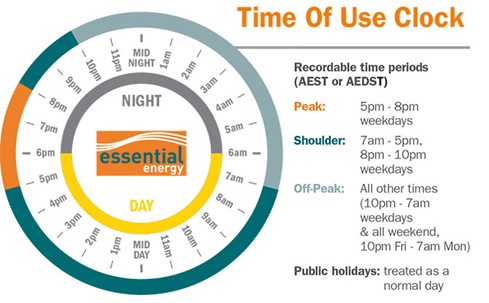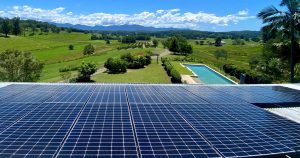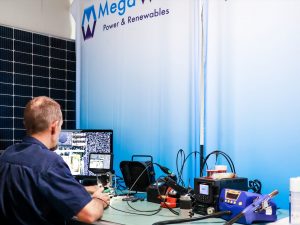Getting Started
At Mega Watt Power, we believe great service means thinking ten steps ahead for our customers-even if they never see what goes on behind the scenes. This is a technical companion to our blog about the new battery rebate and how we do things differently.
We prepared this blog because some customers want to understand the ‘why’ behind our design choices.
If that’s you, read on. And if it’s not, just know this: we take your system seriously, and we design every install like it’s for our own home.
1. Old Panels vs. New
Q: Should we leave those old panels or start fresh?
Most homes getting batteries already have solar. Often, those old panels are eating up prime roof space. Adding a separate array of panels may be technically possible, but is it wise?
Solar Panel Technology Evolution
Solar panel technology has made significant advancements over the years. While the physical size of solar panels has remained relatively constant, the output of solar cells has seen remarkable improvements. For instance, a 210W solar panel occupies the same roof space as a 465W solar panel.
Many systems installed over a decade ago could be excellent candidates for an upgrade to newer models. For example, if you have 24 panels rated at 210W, this would total a 5kW system. By upgrading to the new 465W panels, you could increase your system’s capacity to an impressive 11.16kW, all while utilizing the same rooftop area.
What we consider:
-
- How you use your power by going over your current energy bills.
-
- Will you receive an export limitation and how will that effect you?
-
- Are the old panels underperforming, mismatched, or from a defunct brand?
-
- Will upgrading to new panels provide a better financial outcome?
-
- Will a larger battery be better now for future needs?
What we often recommend:
-
- If the budget allows, replace the old panels with a new, efficient array.
-
- Upgrade to a larger battery now to receive the largest rebate possible.
-
- Long-term, one clean system is often safer, simpler, and more future-proof.
-
- Consider signing up to a VPP and what benefits this can offer.
2. The Battery Isn’t Just a Battery
A battery is not a plug-and-play toaster. It needs:
-
- The right inverter (hybrid or dedicated)
-
- Smart software config (to avoid errors or inefficiencies)
-
- Room to expand if your energy needs grows
-
- WiFi monitoring (to allow fast service)
We design with these in mind:
-
- Backup capability (what you want running in a blackout)
-
- Daytime charging strategy (especially with export limits in some areas)
-
- How to use your excess energy/battery to boost your hot water without using the gird
-
- Potential VPP (Virtual Power Plant) participation and the benefits
-
- Compatibility with evolving tech and tariff structures
3. Understanding your energy bills
How Time-of-Use Tariffs Work:
Peak: High-demand periods, usually with the highest electricity rates.
Off-Peak: Low-demand periods, usually with the lowest electricity rates.
Shoulder: Periods between peak and off-peak, with rates between the two.
Smart Meter: Smart meters provide data on your energy usage, allowing you to identify patterns and shift your usage to cheaper times.
Shifting usage: By using more energy during off-peak times (e.g., running appliances like washing machines or dishwashers at night), you can reduce your overall energy costs.
Example: In some areas, peak times might be during the late afternoon and evening (e.g., 4pm to 8pm), while off-peak is overnight (e.g., 10pm to 7am).
Shoulder periods could be during the middle of the day or other times outside of peak hours.
How to Find Your Specific Time-of-Use Periods:
-
- Check your electricity bill or contact your energy retailer.
-
- Refer to your energy distributor’s website for specific time-of-use periods in your area.

4. What Happens If You Add Later?
(Why One-Shot Rebate Matters)
The Federal Battery Rebate is a once-only offer per household. If you add a battery now and need to add another later, that second battery upgrade is currently not eligible from the Federal Governments Cheaper Homes Battery Program Rebate.
This is why we ask upfront:
-
- Are you likely to get an EV?
-
- Do you have a growing family or working-from-home needs?
-
- Want to have a credit on your bills someday?
-
- Are you considering adding a pool someday?
-
- Are you considering adding a granny flat someday?
If the answer is yes, we might size your battery system a little larger now, while it’s 30% cheaper.
5. The True Cost of a Cheap Job
We see ads like this all the time:
‘3kWh battery, $1200 installed! Zero your power bill!’
It’s misleading.
-
- A typical home uses 16–20kWh/day
-
- A 3kWh battery won’t store enough to offset usage
-
- The real danger isn’t fire, it’s disappointment and lost money
A rushed install can also mean:
-
- Incorrect config = battery won’t charge properly
-
- Poor cable routing = system inefficiencies
-
- No aftercare = you’re stuck when issues arise
We price for quality gear, skilled tradespeople, and support when you need us, months or years later.
6. Our Installation Ethics
We say no to dodgy gear, rushed installs, and pushy sales techniques. We take the time to:
-
- Explain your options
-
- Design for your roof, lifestyle, and future needs
-
- Quote transparently and answer your questions
When you work with Mega Watt Power, you get the depth of knowledge built over decades, with the heart of a family-run local business.
Want to know more or get a real design done for your home?
Reach out to us anytime. We’re local, real, and we pick up the phone.
Visit: megawattpower.com.au or call us directly.
Mega Watt Power: Solar and battery installation for people who want things done properly the first time.





